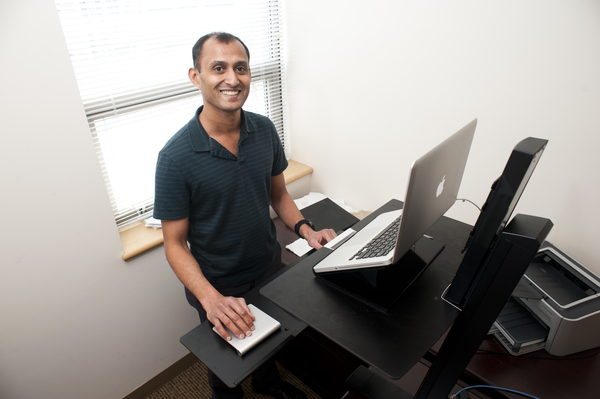Taking a stand – against workplace inactivity

Your desk is making you fat.
That’s the thinking behind the increasing popularity of standing desks, the focus of research by Dinesh John, an assistant professor of health sciences. This semester, John is leading a pilot study focused on observing and monitoring a group of Northeastern staff members equipped with new workstations that allow them to complete their day-to-day tasks on their feet.
“Inaction and obesity are major health issues, but simple modifications to their workspaces can make very real changes,” said John, whose Robinson Hall office is equipped with a device that raises his laptop when he wants to stand and lowers it when he needs to sit. “People may initially be apprehensive, but they come to like the idea that they can be active while they’re working.”
John pointed to studies that have shown sitting for prolonged spans—like a typical eight-hour workday—is harmful to your health, plain and simple. Standing desks and other interventions, he said, can help break long-held habits and lead to a healthier workforce.
John’s academic research focuses on “workplace wellness,” the idea that simple changes in work behaviors—like using a printer on the opposite side of the office or walking to a colleague’s office rather than sending an email—add up over the course of a day and produce significant health benefits. Americans need at least 30 minutes of physical activity each day, he said, adding that much or all of that can be accomplished in the office.
John will collaborate on the pilot study with two Northeastern colleagues—Carmen Sceppa, an associate professor of health sciences, and Jack Dennerlein, a professor of physical therapy. Funded by the Harvard School of Public Health, the study will span eight months, during which the 10 participants will receive baseline health assessments, subsequent health examinations, and individual devices that provide reminders to get up and move around after periods of inactivity.
John joined the Bouvé College of Health Sciences faculty last fall. This research study follows on his previous work at the University of Tennessee–Knoxville, where he examined the feasibility and effectiveness of treadmill desks as a weight-loss tool.
“We found that productivity goes down marginally when people are new to this,” John said, “but because walking and standing are second nature people are very quickly able to use walking or standing desks for between 90 minutes and two hours each day.”
John said employers also stand to benefit from research on the effectiveness of standing desks. If new workstations are shown to improve workers’ health, then lower health-insurance costs and fewer days lost to employees’ illnesses could result.
John also noted that a handful of professors and staff members are already using standing desks or similar equipment on campus. Pete Manolios, an associate professor in the College of Computer and Information Science, uses a treadmill desk in his West Village H office to stay active throughout the day. He got the new workstation two years ago, realizing that his increasingly busy schedule left him less time to stay active.
“I walk about a marathon a week,” Manolios said. “My body works better when I’m active. If I’m just sitting here all day, that’s not an optimal state for me. I feel more alert and energetic using my treadmill workstation.”
None of his co-workers have bought their own treadmill desks—which can retail for more than $1,000—but many have started using standing workstations.
“It’s not a workout, but it’s something that keeps you active when you’d be otherwise sitting all day,” Manolios said. “It’s been a great change to how I work every day.”





